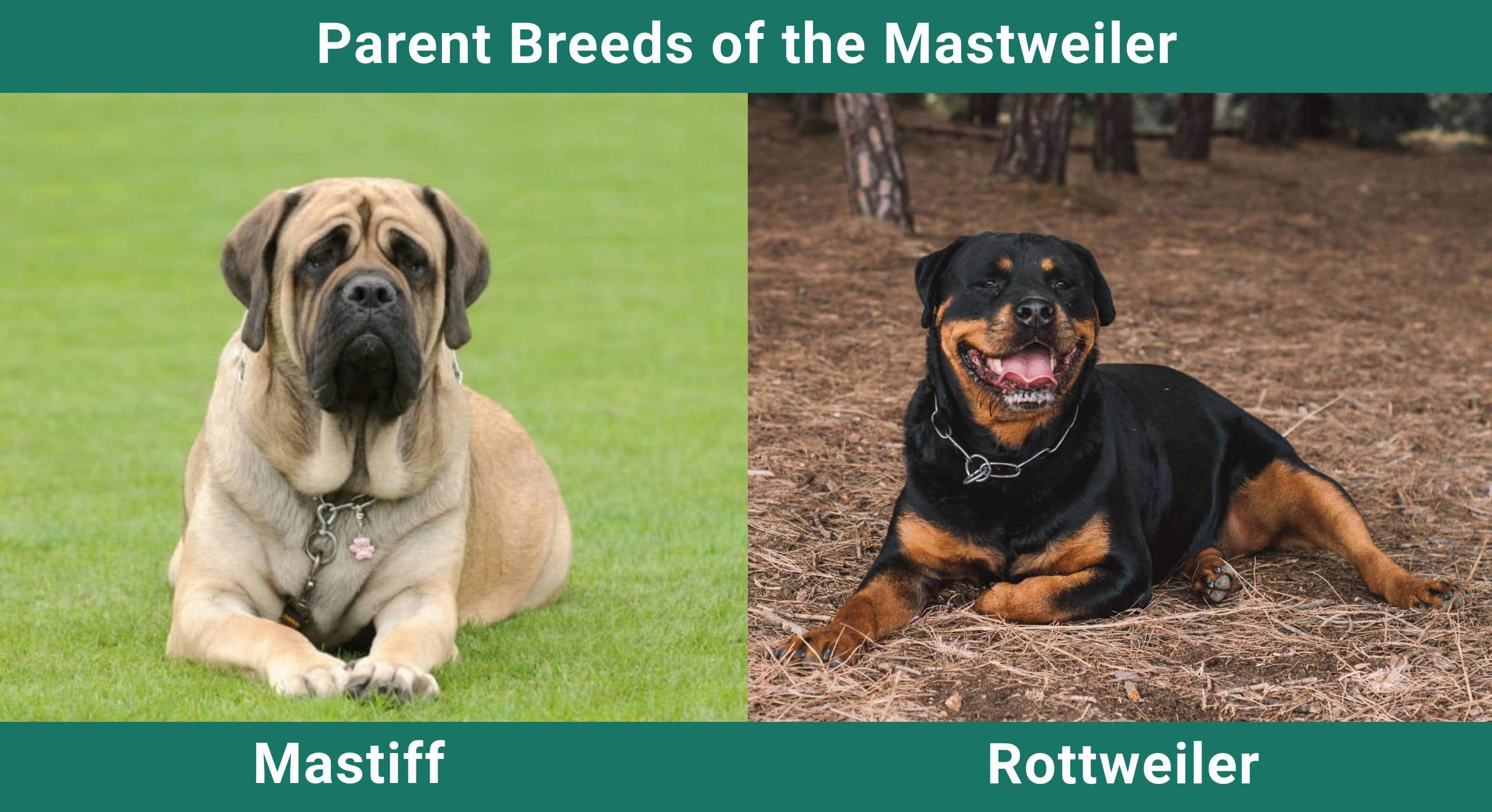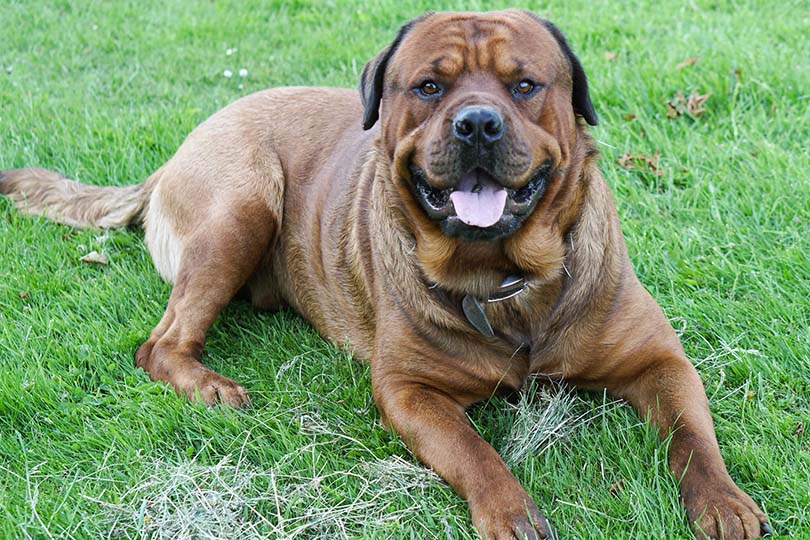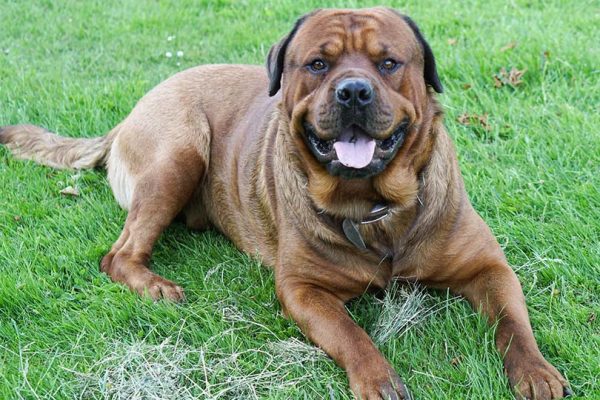Click Below to Skip Ahead
If you want a dog that’s dedicated to your protection and looks intimidating enough to get the job done, the Mastweiler might be just the breed for you.
Breed Overview
Height:
25 – 32 inches
Weight:
80 – 160 pounds
Lifespan:
8 – 12 years
Colors:
Brindle, brown, golden, chocolate, silver, black and tan, black
Suitable for:
Individuals and families, experienced and able to train and handle a large, active dog
Temperament:
Protective, intelligent, loyal, easy-going
This hybrid between the always alert and active Rottweiler and the imposing size but calm demeanor of the Mastiff is the ultimate family guard dog. Best for more experienced owners simply because their size demands a firm touch with handling and training, Mastweilers will happily take up (a lot of) space in your home and your heart! Keep reading to learn more about these calm and devoted dogs.

Mastweiler Puppies
Before you buy, be sure to ask the Mastweiler breeder whether their dogs have been checked for any inherited disease that either Rottweilers or Mastiffs are prone to getting. If you’d rather adopt than buy, you may be able to find Mastweilers available through local animal shelters or rescue groups. You’ll likely find adults rather than puppies for adoption since many potential owners might not have been prepared for how big their cute little Mastweiler puppy was going to get!
Take a look at the full care guide for Mastweilers so they can grow into healthy and happy dogs.

Temperament & Intelligence of the Mastweiler
Because Mastweilers are hybrid dogs, their temperament won’t be as consistent as a purebred dog. Mastiffs, especially English Mastiffs, are more laid-back than Rottweilers and Mastweilers usually have a calmer, sweeter temperament than the more dominant, intense Rottie. They’re watchful, loyal, and protective of their families and property.
Because of their size, early socialization, and training are important to ensure these dogs know how to behave and respect their place in the family. Mastweilers are intelligent dogs but can be hard-headed and unmotivated to learn sometimes. They are best for experienced, patient owners.

Are These Dogs Good for Families?
Despite their intimidating size, Mastweilers usually take well to living with children, especially if they are raised with them. Their protective nature leads them to take on a natural guardian role with their human kids. All children should be supervised when interacting with dogs, but especially with large, sometimes rowdy dogs like the Mastweiler. Mastweilers are usually less energetic and rambunctious than pure Rottweilers, but their size can still be too much for small children.
Because they’re naturally suspicious of strangers, a Mastweiler that’s part of a family with an active social life needs especially diligent socialization. They must be taught to accept lots of friends of all ages coming in and out of their house. Mastweilers, especially Bull Mastweilers, tend towards being territorial.
Does This Breed Get Along with Other Pets?
With proper socialization and supervision, Mastweilers can get along with other family dogs. Again, because of their guard dog heritage, the same may not apply to strange dogs that enter their territory. Because of this, and because the Mastweiler is almost always going to be the bigger dog, caution will always be needed when they interact with other canines.
Some Mastweilers, especially Bull Mastweilers, tend to chase cats. Others may get along fine with the family feline. A lot depends on the individual animals involved and the socialization and training of the Mastweiler. To avoid any predator stress, small exotic pets should be kept away from the Mastweiler.

Things to Know When Owning a Mastweiler:
If you think you have space in your home and life for a Mastweiler, the next step is to find out all you can about what’s needed to take care of these giant dogs. Here are some details about the everyday maintenance of the Mastweiler, as well as health concerns you need to be aware of for the breed.
Food & Diet Requirements
As you might imagine, Mastweilers eat a lot of food! They should do well on any nutritionally balanced dog food, commercial or home-cooked. Your veterinarian can help you determine how much food to feed your Mastweiler to ensure they get all the right nutrition and stay at a healthy weight.
Because bloat is such a serious concern for giant breeds like the Mastweiler, it’s usually recommended that their daily food quantity be split into several small meals to help avoid any problems.
Exercise
English Mastiffs are among the least energetic of dog breeds, while Bullmastiffs, and especially Rottweilers are active and athletic. Mastweilers generally fall somewhere in the middle when it comes to their energy level. They need daily exercise but the intensity will depend on the individual dog.
Mastweilers need outdoor exercise to stay both physically and mentally healthy. Some Mastweilers will get bored or lazy if not stimulated with regular activity. Backyard playtime and long walks or hikes allow the Mastweiler to enjoy time with their family as they burn off some energy. Just keep in mind that Mastweilers don’t tolerate heat very well because of their size and you should use caution if you’re exercising them in hot weather.
Training
As with all large, powerful dogs, early and consistent training and socialization are essential to make sure a Mastweiler is under control and on their best behavior as they grow. These dogs are usually quite intelligent but training can sometimes take some effort. While they usually bond closely with their owners and want to please, Mastweilers can also be prone to stubbornness and sometimes dominance, especially Bull Mastweilers.
Good habits and behavior are most easily taught when these dogs are young and small, so puppy training and socialization classes are a fine idea. Patient, positive, reward-based training methods work best with the Mastweiler, as they do most dogs. Getting into a power struggle with this breed or using harsh punishment will be ineffective and might lead the dog to develop aggressive, negative behaviors.
Grooming ✂️
Despite having a short coat, the Mastweiler is not a hypoallergenic or low-shedding breed. They shed a moderate amount and need weekly brushing to help control the hair and keep their coat healthy. Mastiffs and Bullmastiffs are known for their heavy drooling, but the mix with Rottweiler tends to reduce this tendency in most Mastweilers.
Bathe a Mastweiler as needed to keep them clean and control any doggy odor. Regular ear cleaning and teeth brushing are also good ideas. Keep their nails trimmed short if they don’t stay worn down naturally. For your own sake, or the sake of the veterinary staff who will one day be doing nail trims on your more than 100-pound dog, try to get your Mastweiler accustomed to these grooming tasks when they are still puppies.
Health and Conditions
As a hybrid dog, Mastweilers could inherit any health conditions that are common in either parent breed. When you search for a Mastweiler breeder, look for one who prioritizes breeding only from healthy, properly screened dogs.
- Allergies
- Inherited eye issues
- Obesity
- Hip and elbow dysplasia
- Bone cancer
- Heart problems
- Bloat

Male vs Female
Male Mastweilers are generally larger and heavier than females. They may also be more rambunctious and dominant in personality. Males may be more prone to being territorial and aggressive than females, requiring firmer training and handling.
Female Mastweilers tend to be a little calmer and more affectionate than males. They’re still loyal and protective but they may prioritize caring for the people in the family rather than guarding the house and property as a whole.
Neutering a male Mastweiler can help make him calmer and easier to handle. It may also help with any urine marking issues. If you don’t spay your female Mastweiler, you’ll be dealing with a messy heat cycle about twice a year or so. Keep in mind that any medical procedure is going to be more expensive the larger a dog is and spaying is the more expensive of the two surgeries.
3 Little-Known Facts About the Mastweiler
1. They can be a mix of Rottweiler and any type of Mastiff.
The most popular type of Mastweiler is the mix of Rottweiler with English Mastiff, sometimes distinguished as an English Mastweiler. Another common type is the Bull Mastweiler, a cross of the Rottweiler and Bullmastiff.
2. English Mastweilers were designed with a purpose.
It’s believed that English Mastweilers was created by dog lovers in England looking to create an ideal working and guard dog with the mellow temperament of a Mastiff and the energy and agility of a Rottweiler.
3. Mastweilers can look very different.
The common denominator among all Mastweilers is that they’re going to be big, powerful dogs. Aside from that, they could be one of several different colors and coat patterns. Their actual size can also vary quite a bit depending on what kind of Mastiff the Rottweiler is mixed with and how big both parents are.

Summary
Mastweilers won’t fit, sometimes literally, into every household and living situation. Those who are up for the challenge of living with these courageous beasts must make sure they can afford both the expense and the time it takes to train and socialize a Mastweiler. A Mastweiler will literally help protect your investment along with your home and family as well!
See also:
- Rottaf (Rottweiler & Afghan Hound Mix)
- Saint Weiler (Saint Bernard & Rottweiler Mix)
- Rottweiler Corgi Mix
Featured Image Credit: Digging dog, Anne, Flickr, Attribution CC 2.0







